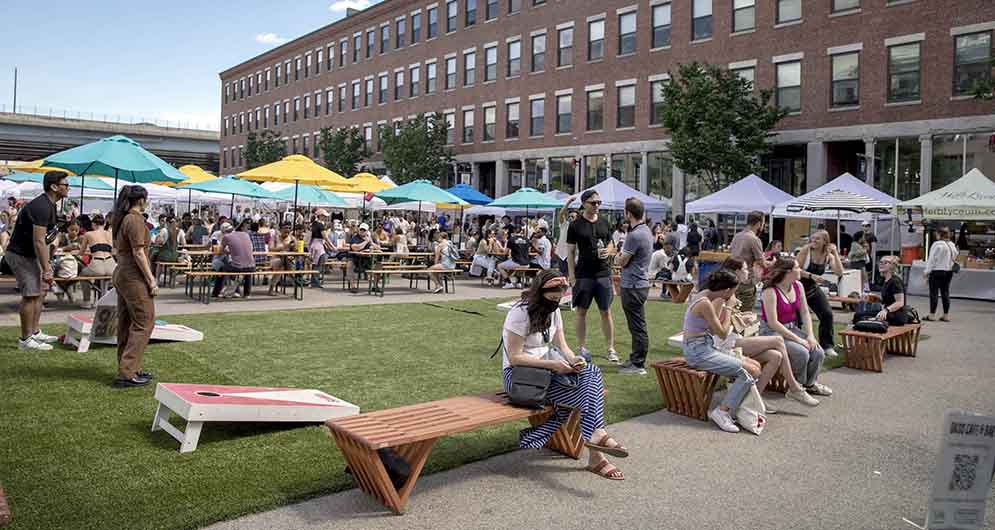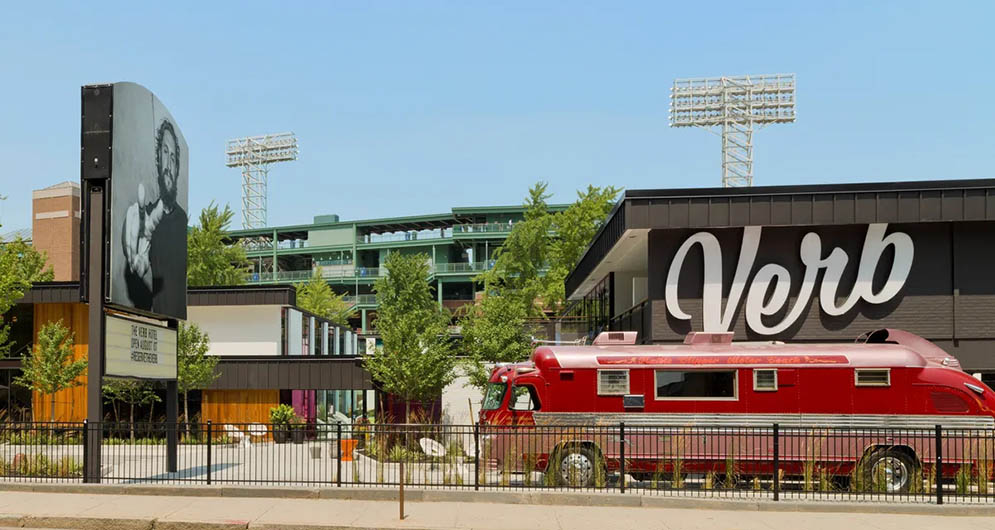There’s a Boston that lives in postcards — red-brick Freedom Trail streets, the golden dome of the Massachusetts State House, duck boats floating by. But there’s also a quieter, subtler Boston. A city of local routines, secret corners, and weekend rituals that unfold away from the tourist throngs. This is the Boston I set out to explore — not just to see the city, but to feel it, to inhabit it, if only briefly, like someone who calls it home.
A Morning in the South End: Coffee, Canines, and Community
My first stop was the South End — not South Boston (or “Southie”), but the elegant, tree-lined neighborhood tucked between Back Bay and Roxbury. It’s a place that balances historical architecture with modern living, where brownstones sit quietly beside contemporary galleries and cafes.
I started my morning at Render Coffee, a local favorite tucked along Columbus Avenue. I sat on the back patio with a cold brew and a flaky ham-and-cheese croissant, surrounded by laptop-tapping locals and dogs happily lounging under chairs. The café’s intimate charm and communal rhythm set the tone for the day.
From there, I strolled through Peters Park, where dog walkers chatted like neighbors from a TV show. In the nearby SoWa Art + Design District, converted warehouses now house artist studios, antique shops, and independent boutiques. No big brands, no cookie-cutter souvenirs — just quiet creativity and real people working on their craft.

Cambridge by Foot (and Flavor)
Many tourists come to Cambridge only for a quick photo-op at Harvard Yard. But cross Massachusetts Avenue or wander a few blocks, and you’ll find a world that’s equally intellectual and delightfully normal.
I spent the afternoon in Inman Square, a triangle of culture where dive bars, ramen joints, and Ethiopian cafés exist in harmony. At 1369 Coffee House, I watched as the barista knew everyone’s name and order. I took mine to go and wandered down Cambridge Street, stopping to peek into quirky bookstores and local galleries.
Later, I had dinner at Oleana, a Mediterranean restaurant with a lush patio hidden behind the building — a true oasis. Their chickpea terrine and baked Alaska are legendary for good reason. It wasn’t cheap, but it didn’t feel performative. It felt like a secret you’re only told if someone thinks you’ll understand.
Jamaica Plain: Nature and Neighborhood
Boston’s Emerald Necklace park system threads through many neighborhoods, but Jamaica Plain (JP) wears its green heart proudly. I arrived late morning and joined the steady stream of joggers, families, and musicians circling Jamaica Pond. Locals waved to each other, often stopping for quick chats with their dogs in tow. There was no rush here — just rhythm.
On Centre Street, JP’s main drag, I browsed used books at Papercuts, a cozy indie bookstore where the staff don’t just sell books, they recommend them like a friend would. I popped into City Feed & Supply, a half-café, half-grocer, where I grabbed a sandwich and a lemon seltzer and took it to The Arnold Arboretum nearby. It’s Harvard-owned, but entirely open to the public. I lay on the grass under a towering magnolia and watched clouds drift across an open sky.
There were no lines. No maps. Just a neighborhood being itself.
The Real North End: Before Dinner Rush
The North End is Boston’s “Little Italy,” and it’s no secret. By dinner, the streets become clogged with tourists queueing for cannoli. But come earlier — say, mid-afternoon — and the atmosphere shifts.
I wandered down Salem Street past tiny groceries like Salumeria Italiana, where I picked up some truffle pecorino and a roll of fresh focaccia. At Bricco Panetteria, you enter a hidden alley to reach a bakery that feels transported from Florence. I chatted in broken Italian with the man behind the counter as he wrapped my bread in brown paper.
I took my bounty to the Christopher Columbus Park just past Hanover Street, where locals were reading on benches and kids were running through fountains. Behind me, I overheard elderly men debating soccer scores in Neapolitan dialect. It felt like eavesdropping on history.
Live Like a Local: Nightlife Beyond the Obvious
When night falls, locals don’t always hit the glitzy bars downtown. One evening, I made my way to Allston, the unofficial hub for students and emerging artists. It’s rougher around the edges, but the energy is palpable. I caught a live set at O’Brien’s Pub, where the drinks are cheap and the music honest. No flashy cocktails — just good sound, dim lights, and people who are there to actually listen.
Another night I ended up in Dorchester at DBar, a restaurant that seamlessly transforms into a lively queer-friendly bar after dinner hours. The staff danced behind the bar. Strangers became fast friends. It felt like a house party where everyone was welcome.
Where to Stay (If You Want to Blend In)
Most travelers head straight for hotels in Back Bay or Downtown Crossing — which are fine, but don’t always reflect the texture of real Boston. If you want to feel like part of the city, consider staying in:
The Revolution Hotel (South End): Trendy but affordable, with shared and private room options, free bike rentals, and art everywhere. It’s walkable to just about everything and near great local eateries.
Airbnbs in Jamaica Plain or Cambridge: These offer a quiet base with easy transit access and real neighborhood flavor. Morning coffee on a shaded porch? Yes, please.
The Verb Hotel (Fenway): For music lovers, this retro-cool hotel backs onto Fenway Park and is themed around rock and roll. Locals love its restaurant, too.

Tips for Seeing the City Through a Local Lens
1. Skip the Hop-On Bus. Ride the T Instead.
Boston’s subway (the “T”) is small but effective. Get a CharlieCard and ride like a local. The Red Line gives you Harvard and MIT. The Orange Line takes you through JP. The Green Line? A scenic, slow crawl through historic neighborhoods.
2. Farmer’s Markets Over Food Courts.
Don’t settle for mall food. Copley Square Farmer’s Market offers fresh produce and local baked goods. SoWa Open Market on weekends includes food trucks, local artists, and a beer garden — all with a relaxed, community vibe.
3. Walk More Than You Think.
Boston is famously walkable. Take side streets. Ditch Google Maps for a bit. Follow the scent of roasted coffee or the sound of a street violinist. The city rewards curiosity.
4. Listen.
Eavesdrop on the Red Line. Chat with a bartender. Read the neighborhood bulletin boards taped to lamp posts. Boston speaks in subtle tones — not just its accent, but its layered identity.
Boston doesn’t ask to be loved. It doesn’t chase your attention like New York or dazzle you with excess like Los Angeles. It’s quieter than that — proud, bookish, a little salty around the edges. It keeps its history tucked behind brick walls, its soul folded into corner pubs and old libraries, waiting patiently for the kind of traveler who prefers to listen before they speak.
This isn’t a city that performs. Boston doesn’t beg for your likes, your TikToks, your bucket list hashtags. Instead, it invites you to lean in. To notice the way the light hits the brownstones in the late afternoon. To listen to the cadence of a Red Line conductor’s voice as the train doors whoosh closed. To walk into a bar and hear a stranger rant about the Sox as if it were a matter of national security.
When you begin to experience the city the way locals do — in the pause before the crosswalk light changes, in the back garden of a family-run restaurant, in the hush of the Boston Common before the world wakes up — you realize this city is built not just of granite and cobblestones, but of fiercely guarded rituals. Sunday morning strolls with a coffee in hand. Midweek trivia nights at a pub that’s been around since before you were born. Farmers’ markets that feel more like reunions than errands. You aren’t just seeing Boston; you’re starting to understand how it breathes.
Forget the checklist. Skip the line for the duck boats. Let go of the idea that you need to “do” Boston. Instead, build your experience from the ground up — not around landmarks, but around feelings. From coffee shops where the barista remembers your name, to bookstores where the handwritten staff picks are better than any bestseller list. From hidden courtyards filled with laughter to corner seats at neighborhood bars where time seems to slow down.
Traveling through Boston like this — slowly, sideways — is about finding your own rhythm within the city’s. It’s not about seeing more; it’s about seeing better.
Because in the end, the Boston that stays with you isn’t the one in the postcards. It’s the one that unfolds quietly, honestly, when you let it. Not just in Boston — but with Boston.
And that’s the version you’ll remember.
